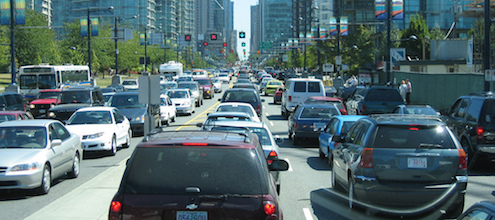
Some like it HOT: High-occupancy toll lanes can be a piece of the congestion puzzle

Last month, Toronto’s plan to implement road tolls on two of its major roads was rejected by the provincial government. It’s not back to square one, however: programs to combat congestion in the GTA continue to grow. Today, as part of a series based on our 2015 report on congestion pricing, we’re discussing high-occupancy toll (HOT) lanes, which Toronto is currently piloting.
Go with the flow
High-occupancy toll (HOT) lanes impose a price on one or more lanes on a road. Their use is entirely optional, which differentiates them from single-entity and zone-based pricing systems. HOT lanes are generally either converted high-occupancy vehicle (HOV) lanes or add-ons to existing highway networks. Whereas HOV lanes are generally restricted to buses and passenger vehicles with multiple occupants, any driver can pay a toll to use a HOT lane. Pricing for HOT lanes is typically either dynamic (responding to usage rates in real time) or variable (set prices that change at set times throughout the day).
In 2016, Toronto launched a HOT lane pilot project on sections of the Queen Elizabeth Way. The city will issue a total of 1,000 vehicle permits via a lottery system every three months, which will cost $180 for the period. Public buses and electric vehicles with green license plates can access the lane for free, as can cars, motorcycles, vans and trucks with at least two occupants. Only those that plan on driving solo down the QEW need a permit. In exchange, they can expect to save time on their daily commute.
Toronto is the first Canadian city to test the waters on HOT lanes. The scope of their program is limited, more a way to gauge the appetite for permits than a comprehensive pricing policy to curb congestion.
HOT, south of the border
There are plenty of smartly designed HOT lane programs from which Toronto and other Canadian cities can learn. One of the best examples is in Minnesota. Back in 2005, the North Star State launched the MnPASS system, one of the world’s first dynamically priced HOT lanes. The project made use of already-built infrastructure, converting underused HOV lanes into HOT lanes. The program has several objectives, including reducing congestion, increasing road capacity, reducing the need for new infrastructure, improving use of public transit, and increasing carpooling.
MnPASS tolls are dynamic and change every three minutes depending on traffic volume and speed. They range from $0.25 to $8.00 but average about $1.50 to $2.00 per trip. Buses, motorcycles and carpools access the MnPASS HOT lanes for free. Single-occupancy vehicles must sign up for an account and pay a transponder lease fee of $1.25 per month. In exchange for these fees, Minnesotan commuters are guaranteed that the MnPASS lanes will flow at over 60 mph (97 km/h) during peak-travel times.
The MnPASS system has proven moderately effective at reducing congestion. Traffic speeds in adjacent general purpose lanes increased by a modest 6%, and total corridor throughput during peak hours increased by 5% on I-394, while traffic throughput on other non-MnPASS corridors decreased slightly.
Minnesotans appear to be on board as well. The total number of trips using MnPASS HOT lanes nearly doubled between 2009 and 2013. In a user survey, respondents were asked to select the best things about traveling in the MnPASS toll lanes, with multiple selections optional. Ninety-three percent of respondents identified time savings; 69 percent for less traffic; 69 percent for ability to travel faster; 60 percent said reduced stress, and 50 percent said ease and convenience.
The intent of the MnPASS system was to improve congestion. Revenues were modest, but the price points were still sufficient to cover operating and enforcement costs. Surplus revenues are used to improve the highway and provide additional capital for public transit projects.
Taking the heat off
Congestion pricing will remove some cars from the road, and the revenues can remove even more cars if they are directed towards increasing the availability of alternative transportation options. Tolls also free up municipal tax dollars to be spent on other high priority areas. In a sprawling city with a modest public transit system, they can improve mobility, save everyone time, reduce costs, generate revenue, help with upkeep of roads and improve the availability of substitute modes of transportation.
HOT lanes are an outlier in the congestion pricing universe. They are unique in that drivers can opt in, and those who do not wish to use them can drive as usual, no hassle, which addresses the issue of equity. HOT lanes can also be combined with other congestion programs to create a two-tiered pricing structure. However, given their limited scope, HOT lanes are often less effective at reducing congestion than more comprehensive forms of congestion pricing. Indeed, this may be part of the appeal to some drivers; they don’t force anyone to pay a toll.
HOT lanes could be a foot in the door to introduce commuters to the benefits of a congestion pricing program that’s purely voluntary. But if the ultimate goal is addressing congestion, HOT lanes may be only be part of the solution.




Comments are closed.